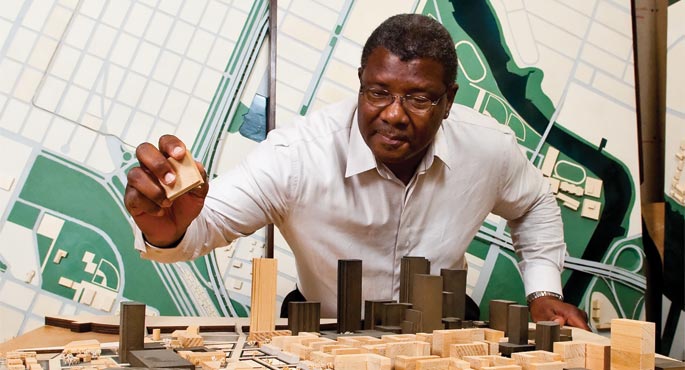Voices
Trent Green
| USF News

Photo by Aimee Blodgett | USF News
As a teenager, Trent Green marveled at his father's skill in renovating the family home — an impressive accomplishment considering his father learned all his construction skills without a formal education. While the experience sparked a passion for architecture in the teen, it would not be until he completed a stint in the army that Green would pursue a degree in the field.
"I was stationed in Germany working with nuclear missiles and I realized I was on the wrong side of the equation," Green recalls. "I was more interested in construction than destruction. When I returned from military service, I went to school."
Today, Green is associate professor of architecture and urban design at USF. He holds a master's degree in architecture and urban design from Harvard University's Graduate School of Design, and a bachelor's degree in architecture from Hampton Institute.
In 1991, after more than 11 years in public and private practice, Green returned home to Florida, joining the faculty of USF. In addition to teaching and research, Green has developed community revitalization strategies and urban design plans for several Florida communities. He was recently an adviser on the Tampa Rail Project and has published numerous urban design reports and lectured on issues related to downtown and community development, African-American Heritage and affordable housing design.
USF: What is the most important thing you teach your students?
Many schools approach design from the standpoint of conceiving every building as a work of art. I help students understand that each building they design has a role to play in defining the urban context. Buildings should be viewed as both art objects and urban fabric.
USF: How do you get your students involved in community design projects?
Students are always involved in some type of instructional alternative to the classroom. We create opportunities for students to come face to face with community residents to understand something about their community development issues and aspirations and to make a meaningful contribution.
USF: Is there one community design project of which you are most proud?
My work in East Tampa — it's an ongoing [revitalization] effort. I keep looking for ways to plug into the process and help move it forward. People in the community know that we are advocates for them and can help in many ways.
USF: What is the greatest community redevelopment opportunity in Tampa Bay?
The City of Tampa received a significant grant from the federal government for urban and community design activities as part of its sustainable communities initiative. The money will be used to identify economic and community redevelopment opportunities downtown and in several adjacent communities. If successful, it could be a turning point for the city and the metropolitan region.
USF: What would people be surprised to know about you?
How I grew up and how I'd like to conclude my career. I'd like to end my professional career with the same passion I had for design and the built environment when I started, but working with teenagers to introduce them to the type of work we do and help them understand the urban context and the potential in every community.
USF: If only I could build...
As an architect, one part of me still aspires to design a significant high-rise building. On the other hand, it would be gratifying to know that my urban design plans will serve as living documents for the long-range growth and development of several communities.
Quick Takes
Urban or suburban: Urban
Your hero: My father
Proudest moment: Having my first son
Design or build: The two are inextricable